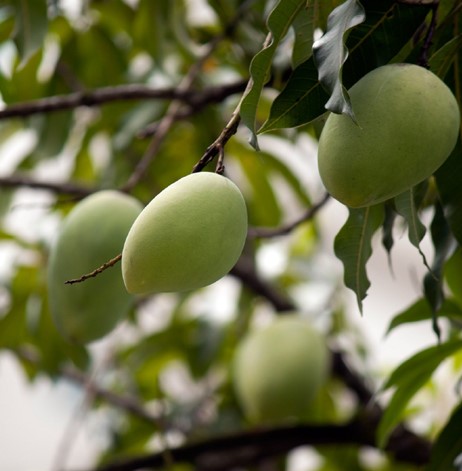




The mango is recognized as one of the finest tropical fruits. The taste and scent characteristics of our Chato mangos from Ica are one-of-a-kind in the world. The pulp is fleshy, soft, juicy, and sweet, and its color ranges from yellow to orange.
ITS SCIENTIFIC NAME IS MANGIFERA INDICA, AND IT IS AN ARBOREAL SPECIES BELONGING TO THE ANACARDIACEAE FAMILY.
The mango originally comes from the Indo-Burmese area, and probably first appeared more than 4,000 years ago. India continues to be the primary zone for the farming of this plant. Peru is currently the fifth largest mango exporter in the world.
The mango is also known in Peru as the melocotón de los trópicos, or “peach of the tropics.”


Every 100g of fresh fruit contains:
Approximately 51 kilocalories
Contains 13,4 g of carbohydrates, 1,4 g of fiber, 10,3 g of sugar.
B1 (thiamin), B2 (riboflavin), B3 (niacin), B6, C (ascorbic acid): 56,4 mg.
Calcium: 13 mg, Magnesium: 12 mg, Phosphorus: 8 mg, Potassium: 108 mg, Sodium: 1 mg, Magnesium: 0,82 mg.
It is one of the fruits with the greatest antioxidant properties, thanks to its wealth of malic, palmitic, p-coumaric, and myristic acids, as well as vitamins A and C. Antioxidants help strengthen the body’s defenses and neutralize free radicals that cause aging and diseases such as cancer.
200 g of mango provide 60% of the daily recommended dose of vitamin C.


The mango is recognized as one of the finest tropical fruits. The taste and scent characteristics of our Chato mangos from Ica are one-of-a-kind in the world. The pulp is fleshy, soft, juicy, and sweet, and its color ranges from yellow to orange.

ITS SCIENTIFIC NAME IS MANGIFERA INDICA, AND IT IS AN ARBOREAL SPECIES BELONGING TO THE ANACARDIACEAE FAMILY.
The mango originally comes from the Indo-Burmese area, and probably first appeared more than 4,000 years ago. India continues to be the primary zone for the farming of this plant. Peru is currently the fifth largest mango exporter in the world.
The mango is also known in Peru as the melocotón de los trópicos, or “peach of the tropics.”

Every 100g of fresh fruit contains:
Approximately 65 kilocalories
Contains 15,5 g of carbohydrates, 1,5 g of fiber, 14 g of sugar
Vitamin A: 207 µg,Vitamins B1, B2, B3, B5, B6 and B9, Vitamin C: 37 mg, Vitamins E: 1 mg, Folic acid: 31 µg / 36 µg.
Potassium: 170 mg,Phosphorus: 22 mg,Magnesium: 18 mg,Calcium: 15 mg.

It is one of the fruits with the greatest antioxidant properties, thanks to its wealth of malic, palmitic, p-coumaric, and myristic acids, as well as vitamins A and C. Antioxidants help strengthen the body’s defenses and neutralize free radicals that cause aging and diseases such as cancer.
200 g of mango provide 60% of the daily recommended dose of vitamin C.



Keep In Touch
Tel: +52 (1) 998 225 3417
S.M. 312, Residencial Isla Azul, calle Santa Lucia, casa 6
– N. Int 6
C.P. 77560 Cancún – Quintana Roo